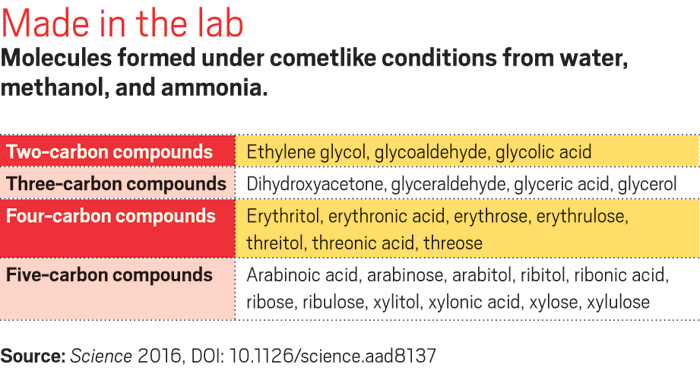Advertisement
Grab your lab coat. Let's get started
Welcome!
Welcome!
Create an account below to get 6 C&EN articles per month, receive newsletters and more - all free.
It seems this is your first time logging in online. Please enter the following information to continue.
As an ACS member you automatically get access to this site. All we need is few more details to create your reading experience.
Not you? Sign in with a different account.
Not you? Sign in with a different account.
ERROR 1
ERROR 1
ERROR 2
ERROR 2
ERROR 2
ERROR 2
ERROR 2
Password and Confirm password must match.
If you have an ACS member number, please enter it here so we can link this account to your membership. (optional)
ERROR 2
ACS values your privacy. By submitting your information, you are gaining access to C&EN and subscribing to our weekly newsletter. We use the information you provide to make your reading experience better, and we will never sell your data to third party members.
Biological Chemistry
Comet collisions may have helped seed life on Earth, lab experiment shows
Researchers produce ribose—a sugar important to sustaining life—in the icy conditions experienced by comets in outer space
by Sarah Everts
April 7, 2016
| A version of this story appeared in
Volume 94, Issue 15
By exposing methanol, water, and ammonia—simple compounds found in the ice of comets—to conditions found in outer space—ultraviolet radiation and icy cold temperatures—researchers have formed a diversity of organic molecules in the lab. One of these molecules, the five-carbon sugar ribose, typically appears in the backbone of ribonucleic acid (RNA), a candidate for the first self-replicating genetic material used by life on Earth, explains Uwe Meierhenrich, a physical chemist at the University of Nice, who led the research (Science 2016, DOI: 10.1126/science.aad8137).
If Meierhenrich’s lab model of interstellar ice holds true in outer space, the new results support the theory that organic material required to seed life on Earth could have come from a series of comet collisions.
“When you think of the origin of life on Earth, it’s very intriguing that sugars, particularly those that form an essential part of the RNA backbone, might be right there on small icy grains waiting to be delivered to our planet,” comments Michael P. Callahan, who studies origin-of-life chemistry at Boise State University. “It is amazing to see the diversity of relatively complicated sugars coming from simple ice mixtures,” he adds.
Meierhenrich and his team propose that ribose is formed in their comet model through a formose reaction, a process that involves the formation of sugars from formaldehyde building blocks. They suggest that formaldehyde first condenses with itself in an autocatalysis reaction to form glycolaldehyde, thereby kicking off a series of reactions that eventually results in ribose and other five-carbon sugars.
If sugars such as ribose can be synthesized under interstellar ice conditions, these types of compounds may be commonly produced by comets, meteorites, and interstellar dust and gas particles, the researchers suggest. Preliminary data acquired from the Rosetta mission suggest the comet 67P/Churyumov-Gerasimenko carries a variety of complex organic molecules including acetone, propanal, and acetamide that waft off the interstellar body. “Just imagine what we’d find if we could take a core sample from the comet,” Meierhenrich says.
Even if ribose is common on comets, there are still many outstanding questions about how life may have been seeded by organic material originating from outer space, Callahan adds. For example, RNA is composed of



Join the conversation
Contact the reporter
Submit a Letter to the Editor for publication
Engage with us on Twitter